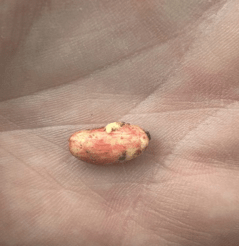You Planted. Now What?
BY Dairyland Seed Agronomy Team
If you are one of the few who decided to start planting or, for the social media crowd, joined the #plant24 party, the question is, now what happens?
One of the first things that a seed does is imbibe, or take in, water. By doing so, it begins the plant’s life cycle. As water enters the seed, it activates enzymes and metabolic processes that cause cells to swell and expand within the embryo and endosperm. This prompts the seed to swell slightly. Shortly afterwards, the radical starts to emerge from the seed.

Figure 1: Notice the radical emerging at the top of the seed.
So, what’s the big deal? Seeds germinate all the time. The first water that the seed imbibes is critical, and we want that water to be warm (50°F or more). The colder the first drink of water is that the seed imbibes, the greater the risk for “Imbibitional Chilling Injury” or Cold Shock Syndrome, which is more apparent when water temperatures are closer to 39°F or less. This cold shock can negatively affect germination and eventually plant population.
A corn seed needs to take in 30 percent of its weight in water, and a soybean seed needs to take in 50 percent of its weight in water, to start the germination process. The interesting aspect of the germination process is that it starts as soon as the seed imbibes water. In corn, a large portion of this process takes place in the first 30 to 90 minutes, with more than 80% of the water taken up in the first 8 to 12 hours. Soybeans can take in, or imbibe, 85-90% of the water in 4 to 6 hours.
Here is the take-home statement: If the first water that the plant takes in is warm, that seed should be fine. Conversely, if we were finishing off a field and it started to get cooler, those seeds or acres planted when it was cooler could see more injury or mortality.
As always, if you have questions regarding this or other agronomic concerns, contact your local Dairyland Seed Agronomist.

Brian Weller
Western Region
507.456.3034

Rod Moran
Western Region
507.456.3034

Dan Ritter
Central Region
219.863.0583

Branden Furseth
Northern Region
608.513.4265

Mark Gibson
Eastern Region
260.330.8968

Amanda Goffnett
Eastern Region
989.400.3793

Ryan Mueller
Eastern Region
989.400.3793
